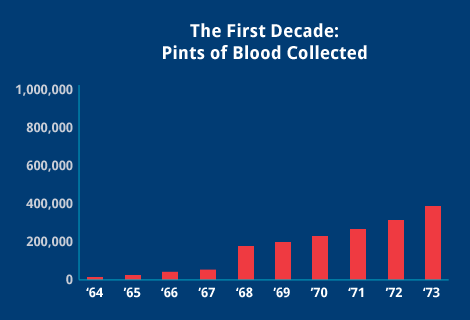1964-1973
During NYBC’s first decade, man first set foot on the moon. Our focus was to provide a safe and reliable blood supply for the region.

- 1964
Support generated by the Community Blood Council of Greater New York and the Public Health Committee of the NY Academy of Medicine’s study of Human Blood in New York City leads to NYBC being established with Aaron Kellner, MD as President. Our Greater NY Blood Program started collecting and supplying blood to area hospitals. Research underway included Dr. Kellner studying the relation of fat in the blood to heart disease and Dr. Fred Allen studying blood groups and human genetics.
- 1965
First centrally administered Blood Donor Program established for municipal employees (now contributing nearly 40,000 donations annually to support our community) First “rare blood” registry established for NY metropolitan area (previously this blood was obtained from Seattle, Milwaukee and Miami).
- 1968
Education and training for medical professionals begins with an emphasis on blood group serology and blood bank technology, as well as medical graduate student programs. The Laboratory of Virology under the direction of Alfred Prince, MD establishes serum hepatitis lab testing. What comes to be known as the “Euroblood Collaboration” with Red Cross centers in Switzerland, West Germany and Belgium begins, accounting for 10-37% of NYBC’s supply.
- 1972
Marked the first five years of the collaborative Greater New York Blood Program with cumulative collections of 315,453 units (collections up 21%) … 423,844 transfusable units distributed to area hospitals. Strong support from 410 volunteers across the region recruited through American Red Cross partnership. Donor Groups: 4,500 with as few as 3 members and up to 35,000 employees. NYBC plans a donor room at the World Trade Center office complex. This site was well utilized by the Wall Street community through 1979, then re-opened in a larger space with more capacity before closing in 1998. Better understanding of liver metabolism and malfunction of protein production in the liver comes from Dr. Colvin Redman and colleagues work in the Membranes Laboratory.
- 1967
AMA’s Today’s Health reports on NYBC’s progress in cryobiology in “Super-Cold: The ‘Hottest’ Thing in Science.”
- 1969
Greater NY Blood Program combines the services and facilities with Community Blood Council and the American Red Cross and later becomes NYBC. NYBC becomes the first US blood center licensed to fractionate transfusable products from plasma. 196,808 units of blood collected from over 172,000 donors. 77% of blood is collected from mobile blood drives at businesses, schools, religious groups, community organizations and government offices.
- 1973
Renovation of 310 East 67th Street headquarters completed through support of the Capital Fund Campaign Committee chaired by then President of NY Telephone, William Ellinghaus. 383 kidneys are donated to the NY-NJ Regional Transplant Program (RTP) supported briefly by centralized resources from NYBC. NYBC/Community Blood Council organizes a 1-3 year Post Doctoral Clinical and Research Training Program for Blood Bank Directors in recognition of an acute shortage of qualified professionals.
- 1971
Automation begins to pave the way for reduced processing times and productivity improvements.
- 1966
Four National Institutes of Health (NIH) grants for a Research Resource Program, Blood Group Antigen-Antibody Reactions, Mobilization of Lipids in Living Animals, and Relation of Ferritin to Iron Metabolism.
